ISSN ONLINE(2319-8753)PRINT(2347-6710)
ISSN ONLINE(2319-8753)PRINT(2347-6710)
K.Sonia1, G.Seshadri2
|
| Related article at Pubmed, Scholar Google |
Visit for more related articles at International Journal of Innovative Research in Science, Engineering and Technology
This paper presents the design of a multi-level inverter with Flexible AC transmission systems (FACTS) capability for small to medium size (10–20kW) permanent-magnet wind applications using modular multi-level converter (MMC) topology. The aim of the paper is to design a new type of inverter with Distribution static synchronous compensator (D-STATCOM) option to provide utilities with more control on active and reactive power transfer of distribution lines. The proposed inverter is placed between the renewable energy source, specifically a wind turbine, and the distribution grid in order to fix the power factor (PF) of the grid at a target value, regardless of wind speed, by regulating active and reactive power required by the grid. The D-STATCOM inverter is capable of controlling active and reactive power by controlling the phase angle (ð›¿) and modulation index (m), respectively. The unique contribution of the proposed work is to combine the two concepts of inverter and D-STATCOM using a voltage source converter (VSC) multi-level topology in a single unit without additional cost. Simulations of the proposed inverter, with 11 levels, have been conducted in MATLAB/Simulink. The main function of the proposed inverter is to transfer the active power to the grid as well as keeping the powerfactor (PF) of the local power lines constant at a target PF regardless of the incoming active power from the wind turbine.
Keywords |
| Modular multilevel converter (MMC), multi-level inverter (MLI), wind energy inverter (WEI). |
INTRODUCTION |
| The main role of power electronics in distribution systemsare greatly increased recently. The power electronic devices are usually used to convert the nonconventionalforms of energy to the suitable energy for power grids,in terms of voltage (v) and frequency (f). In permanent magnet(PM) wind applications, a back-to-back converter is normallyutilized to connect the generator to the grid. A rectifier (AC-DC) isequipped with a maximum power point tracker (MPPT),converts the output power of the wind turbine to a dc power.The dc power is then converted to the desired ac powerfor power lines using an inverter and a transformer. With recentdevelopments in wind energy, utilizing smarter windenergy inverters (WEIs) has become an important issue. Thereis a lot of single-phase lines in the United States [2], whichpower small farms or remote houses. Such customershave the potential to produce their required energy using asmall-to-medium-size wind turbine (10-20kw). Increasing the number ofsmall-to-medium wind turbines are will make several troublesfor local utilities such as harmonics or power factor (PF)issues. |
II.LITERATURE SURVEY |
| Tremendous growth is occurred in the integration of distributed energy systems to the power systems utilizing FACTS technology. A majority of FACTS applications for a renewable energy sources are introduced over the past decade. The unique contribution of the current work is the combination of an inverter and a D-STATCOM (Distribution static synchronous compensator) for renewable energy sources in single-phase systems, using a new multi-level topology. Several key factors are to be considered throughout all stages of the work: 1) cost-effectiveness, 2) efficiency, and 3) compatibility with IEEE standards. In this project, a new single-phase inverter with D-STATCOM capability, using a new multi-level topology calledas modular multi-level converter (MMC), is introduced. The proposed inverter is designed for grid-connected wind turbines in the small- to medium sized (10kW-20kW) range. This new inverter regulates DC link voltage as well as active and reactive power injected to the grid through the distribution transformer in order to set the grid PF at a target value established by the user (utility). The proposed system provides high dynamic performance and power quality for power transmitted between the renewable energy source and the distribution grid. |
III. EXISTING SYSTEM |
| A high PF is generally desirable in a power system todecrease the power losses and improve voltage regulation at theload. It is often desirable to adjust the PF of a system to near1.0. When reactive elements are supply or absorb reactive powernear the load, the apparent power is reduced. In other words,the current drawn by the load is reduced, which decreases thepower losses. Therefore, the voltage regulation is improvedif the reactive power compensation is performed near largeloads. Normally, utilities have to use capacitor banks tocompensate the PF issues, which will increase the total costof the system. |
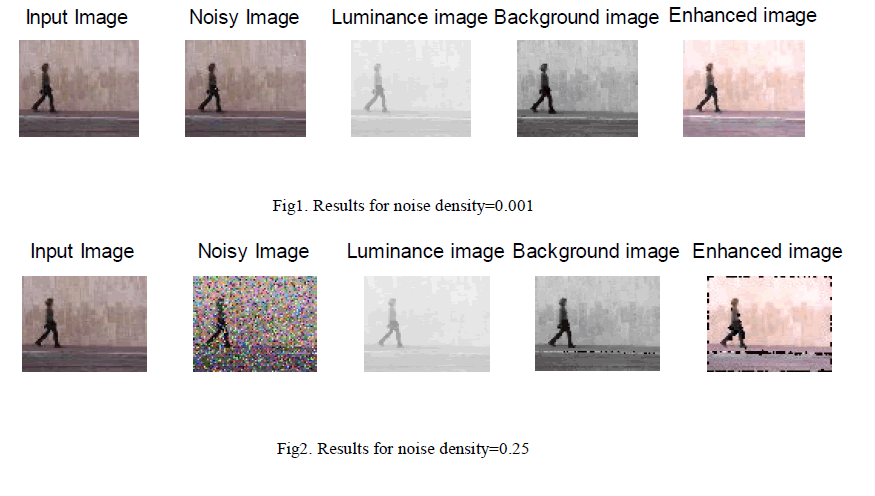 |
IV.PROPOSED METHOD |
| The modern ways of controlling the PF of thesepower lines are to use small distribution static synchronous compensators (D-STATCOMs). The D-STATCOMs are normallyplaced in parallel with the distributed generation (DG) systems aswell as the power systems to operate as a source or sink ofreactive power to increase the power quality issues of thepower lines. By using regular STATCOMs for small-to-medium-size single-phase wind applications does not make the economicsense and increase the total cost of the system significantly. The proposed D-STATCOM inverter in this paper is equipped with aD-STATCOM option to regulate the reactive power of the localdistribution lines and can be placed between the wind turbineand the power grid, same as a regular WEI without any additionalcost. The function of the proposed inverter is not only toconvert dc power coming from dc link to a suitable ac powerfor the main grid, but also to fix the power factor( PF) of the local grid at atarget PF by injecting enough reactive power to the power grid. |
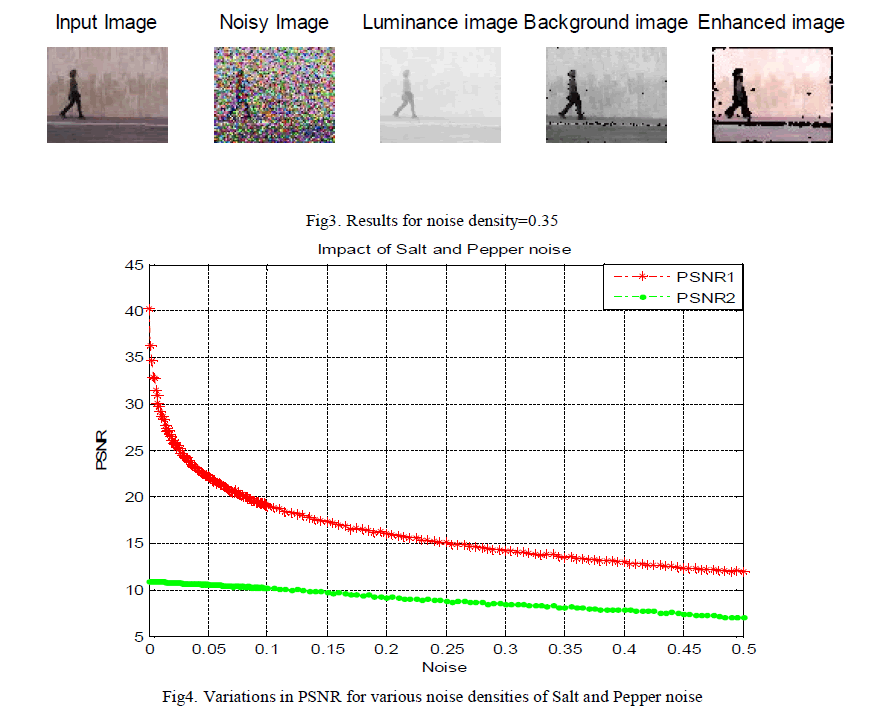 |
| Fig. 2 shows the complete configuration of the proposed inverter. The dc link of the inverter is connected to the wind turbine through a rectifier using MPPT and its output terminal is connected to the utility grid through a seriesconnected second-order filter and a distribution transformer. Thedifferent modulation methods are such as sinusoidal pulse width modulation (PWM), selective harmonic elimination, optimized stepped waveform technique, and space vector modulation technique were discussed and compared [3]-[6]. Among all multilevel topologies, the cascaded Hbridge multilevel converter is very well known for STATCOM applications for several reasonsThe main reason is that it is simple to obtain a high number of levels, which can help to connect STATCOM directly to medium voltage grids .The modular multilevel converter (MMC) was introduced in the early 2000s [7]. This topology consisting of several half-bridge (HB) sub modules (SMs) per each phase, which are connected in series. An n-level single phase MMC consists of a series connection of 2(n − 1) basic SMs and two buffer inductors. Fig.3 shows the proposed controller system. Proposed systemhaving two modes of operation: |
| 1) when the wind is blowing and active power is coming from the wind turbine: the inverter + D-STATCOM mode. In this mode, the device is working as a regular inverter to transfer active power from the renewable energy source to the grid as well as working as a normal D-STATCOM to regulate the reactive power of the grid in order to control the PF of the grid and 2) when wind speed is zero or too low to generate active power: the D-STATCOM mode. In this case, the inverter is acting only as a source of reactive power to control the PF of the grid, as a D-STATCOM. This option eliminates the use of additional capacitor banks or external STATCOMs to regulate the PF of the distribution feeder lines.The relation between the target reactive power and the target PF is, |
 |
| The second function of the controller systems is to keep the capacitors’ voltages balanced. In order to do this, a carrier based pulse width modulation (CPWM) method is used. The third function of the controller system is the PWM generation block. In this block, based on the desired modulation index, power angle, voltages of the capacitors, direction of the current flowing through the switches and the controller generates the PWM signals in order to meet all the system requirements. |
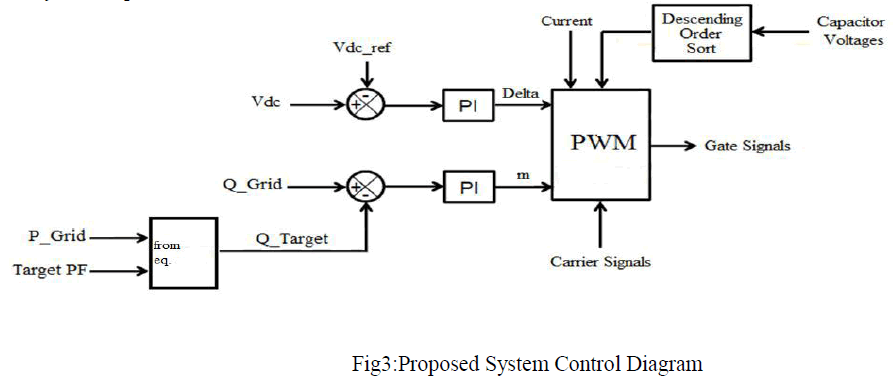 |
V. SIMULATION AND RESULTS |
| The design of an 11-level MMC inverter was carried out in MATLAB/Simulink. The simulation is 20 s long and contains severe ramping and de-ramping of the wind turbine. Simulation of the proposed 11-level D-STATCOM inverter is shown in below. The inverter function is transferring active power from the wind turbine to the distribution grid as well as compensating the PF of the local distribution grid at the target PF of 0.90. Table 1 shows parameter values used for the simulation. |
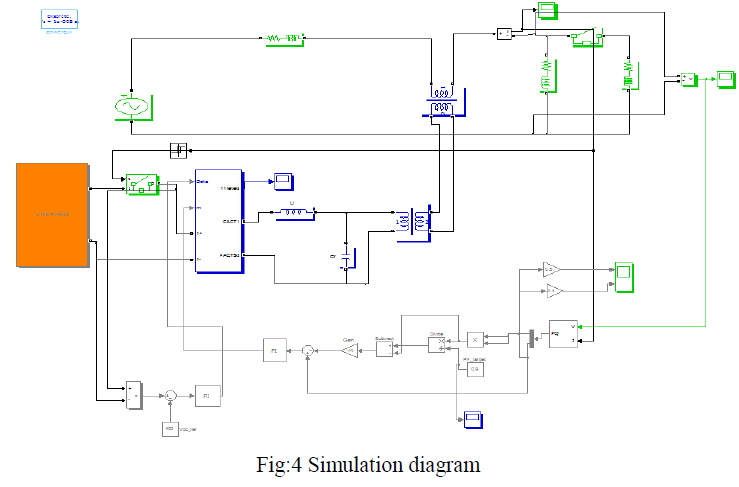 |
| In the 11-level simulation, discrete intervals are used as the amplitudes of the current controlled current sources. However, the output active power of the wind turbine differs because the DC link voltage is different in this case (2000 V in the 11-level model). Therefore, before t=19 s, the output the active power of the wind turbine is zero, representing wind speed is zero or too low to produce active power. After t=19 s, the power provided by the wind turbine ramps up to approximately 15 kW in four seconds and then ramps down to zero in seven seconds, followed by no wind power production for two seconds. |
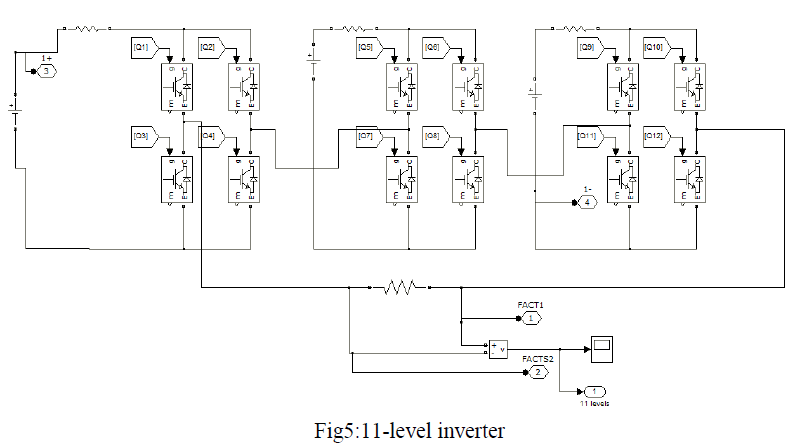 |
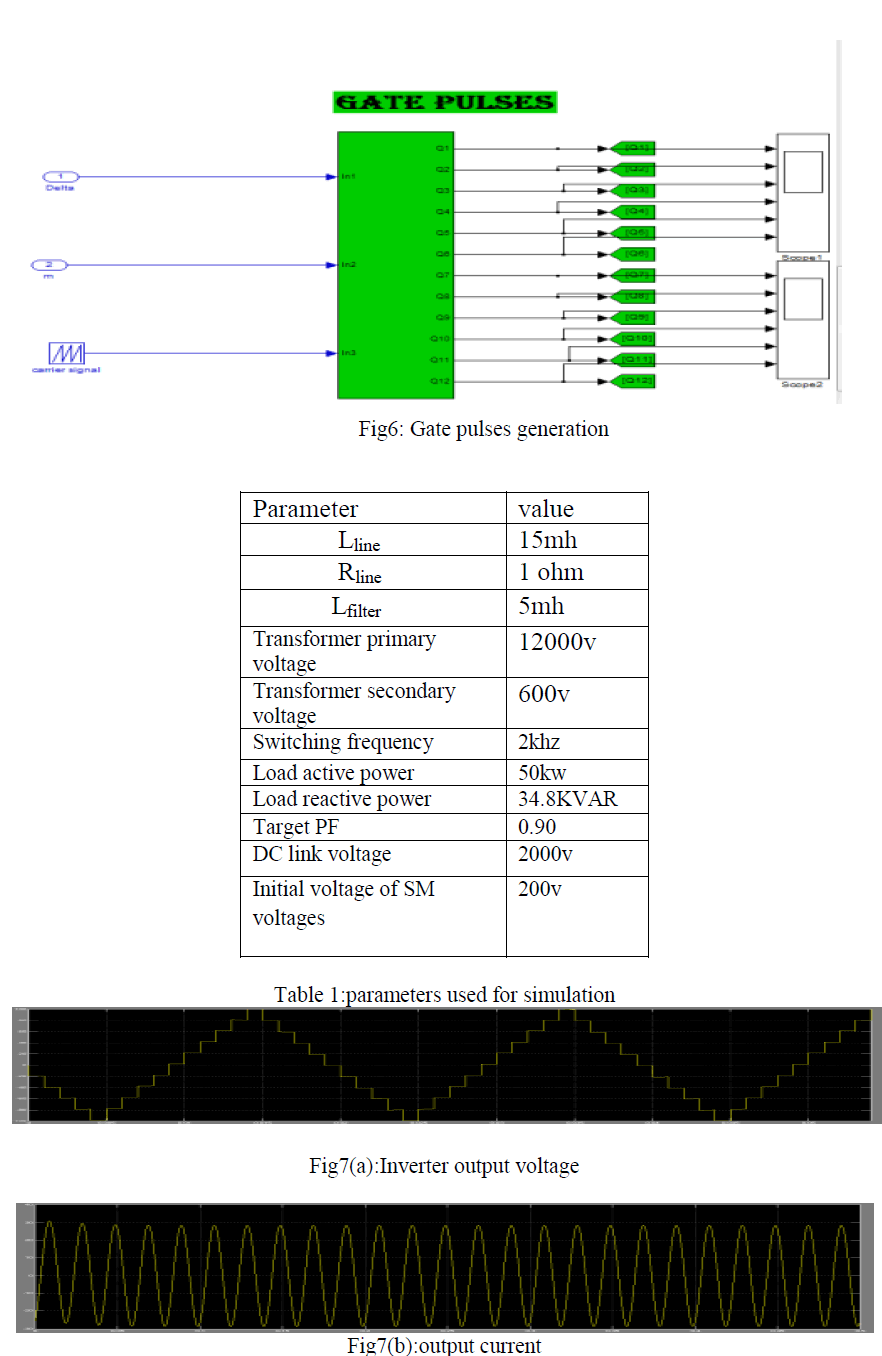 |
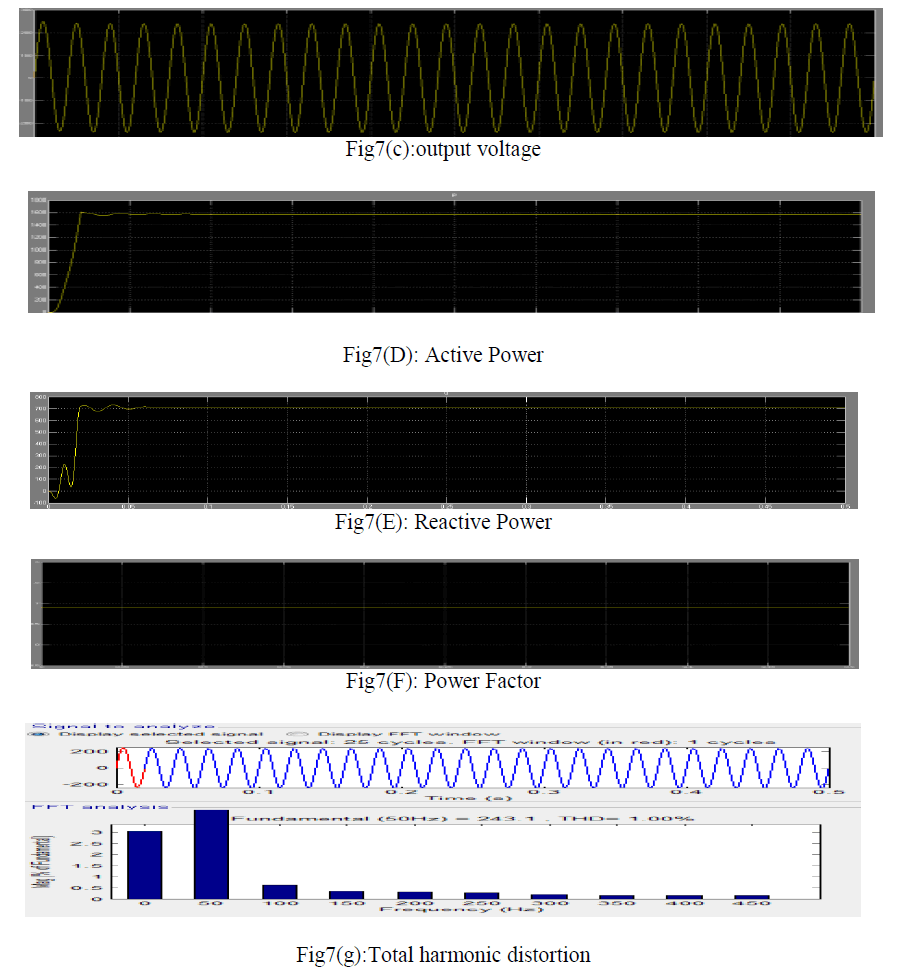 |
VI.CONCLUSION |
| In this paper, the concept of a new multilevel inverter with FACTS capability for small-to-mid-size wind installations is presented. The proposed system demonstrates the application of a new inverter with FACTS capability in a single unit without any additional cost. Replacing the traditional renewable energy inverters with the proposed inverter will eliminate the need of any external STATCOM devices to regulate the PF of the grid.Clearly, depending on the size of the compensation, multiple inverters may be needed to reach the desired PF. The simulation results for an 11-level inverter are presented in MATLAB/Simulink. |
References |
|